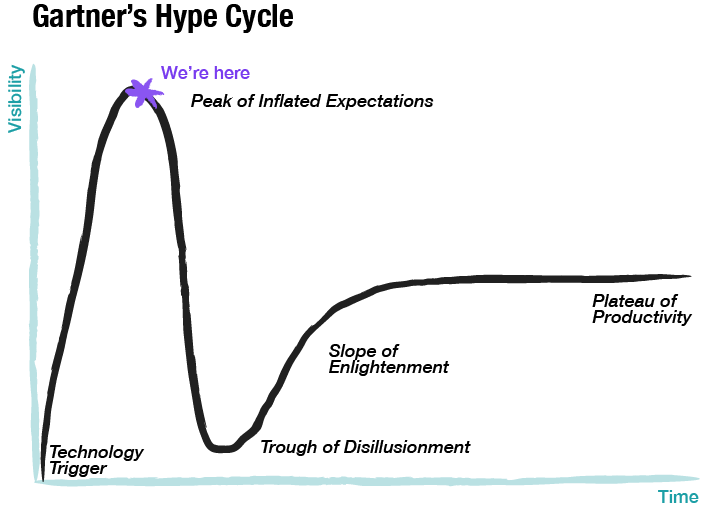AI hype is new, our reaction to it is not
Welcome to Part 2 of our comprehensive 6-part series, Beyond Buzzwords: Finding your Purpose for AI, written together with data science expert Noelle Saldana.
When trying to understand AI in a broader business context, we think it’s helpful to refer to Gartner’s Hype Cycle of technology adoption. This framework reminds us that people and organisations tend to respond in predictable ways to new technology.
When it comes to AI, we think we’re here (where you can see the asterisk on the graph)—the market is getting saturated, and the noise is becoming deafening, and we may be at the peak of inflated expectations. It means that we are quickly heading towards the trough of disillusionment; we’re about to learn the hard way that AI is not infallible and not a quick fix solution to everything.
Illustration of Gartner’s Hype Cycle: *We’re currently here, near the peak of inflated expectations
The current hype around AI reminds us of a similar moment in the early 2000s. When Apple launched the App Store in 2008, it unleashed app mania. Every company at the time felt the need to develop an app, and at its peak, the Apple Store had 2.2 million apps. But not every one of those apps was vital or even moderately successful. Companies spent a lot of effort and money on developing apps that didn’t solve a problem, didn’t deliver sufficient customer value, or were a poor product market fit. So for every killer app or new market created, there were dozens of companies that invested in creating a lot of waste.
Today, similar excitement surrounds the promise and potential of AI. We are in the middle of a paradigm shift, which creates incredible momentum for innovation. However, we also need to be realistic about what it means to incorporate that innovation into our work. We can’t simply “add AI to the menu” of our offerings without doing some real work to understand what that means.
In the App hype era, many companies had unrealistic goals that they could be innovative by creating mobile apps for their products. Companies rushed to be a player in the app space, but ultimately most were not successful in being disruptive to their industries, let alone their own businesses. Similarly, we see a rush to use AI as a means to stay relevant in the current hype AI cycle. To “use AI” encompasses both integrating the technology into a product as well as using AI tools for productivity.
Here are some common things we hear (that you should be on alert for):
Let’s sprinkle some AI on our product. Can we add a ChatGPT chatbot?
I don’t need a designer for my product, I just need Midjourney.
I don’t need a data scientist. My developers can use AI tools.
There is a real risk in only leveraging someone else’s technology, e.g. calling an API and depending on the capabilities and limitations of a different company altogether. What happens when your access changes or seizes? What happens when the AI goes unchecked? Building major components of your business on the back of another company leaves you vulnerable to many external factors like mergers, acquisitions, leadership changes, or drastic changes in direction.
If you want to shape your own AI destiny, you’ll need to bring a human into the loop. Designers, data scientists, and practitioners of any kind don’t just supply the working product—they bring their expertise and critical thinking abilities. They are the ones who will be able to tell you when the tool isn’t working the way it should. If you remove them from the equation, you’re setting yourself up for failure.
We challenge you to be strategic and responsible about AI in order to avoid Gartner’s trough of disillusionment.
In the next parts of this series, we’ll discuss how to find AI opportunities in your products, how to approach exploring applications for AI, determining how much AI is necessary for your intended goals and how to successfully integrate an AI practice into your product development team.
This is part 2 in the series. Read on:
Part 1: Beyond Buzzwords: Finding your Purpose for AI
Part 2: AI Hype is New, Our Reaction To It Is Not
Part 3: Is the product you’re building a good candidate for AI?
Part 4: You are inspired to use AI: Now what?
Part 5: Your AI investment = (AI needs) + (the necessary team)
Part 6: Strategies for successfully integrating an AI practice into your org


